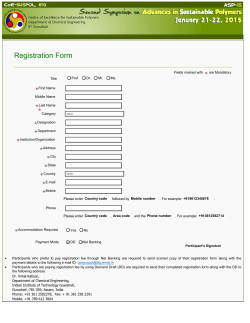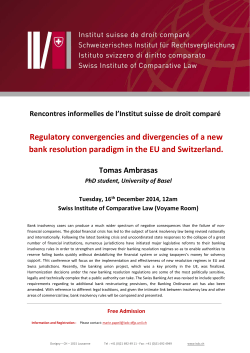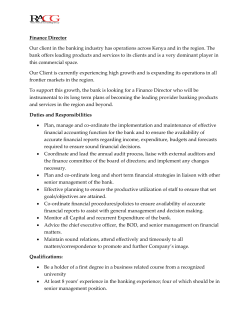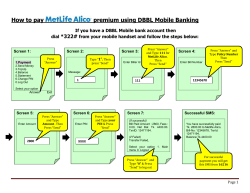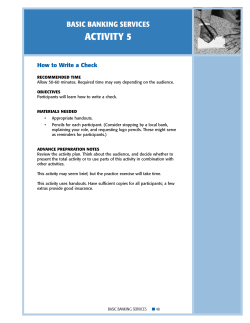
a study on e – channels service quality in private bank tiruchirappalli
International Journal of Management (IJM), ISSN 0976 – 6502(Print), ISSN 0976(IJM) - 6510(Online), INTERNATIONAL JOURNAL OF MANAGEMENT Volume 6, Issue 2, February (2015), pp. 19-30 © IAEME ISSN 0976-6502 (Print) ISSN 0976-6510 (Online) Volume 6, Issue 2, February (2015), pp. 19-30 © IAEME: http://www.iaeme.com/IJM.asp Journal Impact Factor (2015): 7.9270 (Calculated by GISI) www.jifactor.com IJM ©IAEME A STUDY ON E – CHANNELS SERVICE QUALITY IN PRIVATE BANK TIRUCHIRAPPALLI A.S. THOUFIQ NISHATH, MBA Assistant Professor and Research Scholar Jamal Institute of Management, Jamal Mohamed College, Trichy - 20 Dr. A. SELVARANI., MBA, M.Phil., SLET, PGDMM, Ph.D Associate Professor, Jamal Institute of Management, Jamal Mohamed College, Trichy – 20 1. INTRODUCTION Rapid technological advances have introduced significant changes in the global economic and business environment. In this regard, all industries in globe are in one way or another being affected by the advancement of the technological innovation. In the banking industry, bank branches alone are no longer sufficient to provide banking services to cater the needs of today’s sophisticated and demanding customers. The provision of banking services through electronic channels (echannels) namely ATMs, PC banking, phone banking and banking kiosks have provided an alternative means to acquire banking services more conveniently. E-channel, also known as innovative distribution channel (Wong, 1998; Kimball, 1997), or online banking (Daniel, 1999) or technology-intensive delivery system (Filotto, 1997), refers to the methods of delivering financial products using electronic media such as personal computer (PC), the telephone, and the Internet (Dannenberg and Kellner, 1998). More specifically, ATM or the automatic teller machines, is the most commonly used electronic distribution channel that enables bank customers to conduct their banking transactions (deposits, withdrawal or balance enquiry) 24hours a day. Essentially, all banks in Malaysia provide ATM services. Alongside ATMs, phone banking is another e-banking option. With a centralised consumer service department, phone banking provides services such as account balance enquiry, instruction to issue bankers cheques and give standing instructions. Each call will first reach an automated response system, but a consumer may also re-route a call to a service representative. Most banks keep the phone centres open 24-hours a day. Some examples are Direct Access of Southern Bank, Tele-banking of RHB Bank and Maybank. PC banking, or also known as remote e-banking, selfservice banking, home banking and office banking, is the third form of e-banking. 19 International Journal of Management (IJM), ISSN 0976 – 6502(Print), ISSN 0976 - 6510(Online), Volume 6, Issue 2, February (2015), pp. 19-30 © IAEME PC banking could be done via Web-based or Internet. By using a personal computer that is equipped with a modem and loaded with the necessary software, consumers can carry out banking at home or office. PC banking allows consumers to check account balances, credit card activity, transfer funds and bills payment. Another e-channel that is currently available is the banking kiosk (also known as banking booth or virtual kiosk). Banking kiosk is basically the integration of phone banking, ATM and PC-based banking services, where consumers are able to access their account either by telephone, ATM or the computer terminal. At present, banking kiosk services in Malaysia are provided by Phileo Allied Bank (now operating under Maybank). Although the latest technique of e-channels is said to provide convenient services and a reduced operating cost, implementing e-channels involves substantial risks and costs. How should banks integrate the e-channels with existing channels successfully? What would be the appropriate staffs’ training programme? How can customers be encouraged to accept the new delivery channel? How should banks cope with the ever increasing and rapid technological changes in delivering effective services? As such, the basic question is: what would it take to bring about the success in implementing e-channels in banks? 2. BANK – E CHANNELS A. ATM An automated teller machine (ATM), also known as a Cash Point, is a computerized telecommunications device that provides the clients of a financial institution with access to financial transactions in a public space without the need for a cashier, human clerk or bank teller. ATMs are known by various other names including ATM Machine, automatic banking machine, cash machine, and various regional variants derived from trademarks on ATM systems held by particular banks. On most modern ATMs, the customer is identified by inserting a plastic ATM card with a magnetic stripe or a plastic smart card with a chip, that contains a unique card number and some security information such as an expiration date or CVVC (CVV). Authentication is provided by the customer entering a personal identification number (PIN). Using an ATM, customers can access their bank accounts in order to make cash withdrawals, credit card cash advances, and check their account balances as well as purchase prepaid cellphone credit. If the currency being withdrawn from the ATM is different from that which the bank account is denominated in (e.g.: Withdrawing Indian Rupee from a bank account containing US Dollars), the money will be converted at a wholesale exchange rate. Thus, ATMs often provide the best possible exchange rate for foreign travelers and are heavily used for this purpose as well. B. INTERNET BANKING Online banking (or Internet banking) allows customers to conduct financial transactions on a secure website operated by their retail or virtual bank, credit union or building society. Online banking solutions have many features and capabilities in common, but traditionally also have some that are application specific. Features commonly unique to Internet banking include: Personal financial management support, such as importing data into personal accounting software. Some online banking platforms support account aggregation to allow the customers to monitor all of their accounts in one place whether they are with their main bank or with other institutions. C. TELEPHONE BANKING Telephone banking is a service provided by a financial institution, which allows its customers to perform transactions over the telephone. Most telephone banking services use an automated phone answering system with phone keypad response or voice recognition capability. To guarantee 20 International Journal of Management (IJM), ISSN 0976 – 6502(Print), ISSN 0976 - 6510(Online), Volume 6, Issue 2, February (2015), pp. 19-30 © IAEME security, the customer must first authenticate through a numeric or verbal password or through security questions asked by a live representative (see below). With the obvious exception of cash withdrawals and deposits, it offers virtually all the features of an automated teller machine: account balance information and list of latest transactions, electronic bill payments, funds transfers between a customer's accounts, etc. Usually, customers can also speak to a live representative located in a call centre or a branch, although this feature is not always guaranteed to be offered 24/7. In addition to the self-service transactions listed earlier, telephone banking representatives are usually trained to do what was traditionally available only at the branch: loan applications, investment purchases and redemptions, cheque book orders, debit card replacements, change of address, etc. Banks which operate mostly or exclusively by telephone are known as phone banks. They also help modernize the user by using special technology. D. MOBILE BANKING Mobile banking (also known as M-Banking, mbanking, SMS Banking) is a term used for performing balance checks, account transactions, payments, credit applications and other banking transactions through a mobile device such as a mobile phone or Personal Digital Assistant (PDA). The earliest mobile banking services were offered over SMS. With the introduction of the first primitive smart phones with WAP support enabling the use of the mobile web in 1999, the first European banks started to offer mobile banking on this platform to their customers. Mobile banking has until recently (2010) most often been performed via SMS or the Mobile Web. Apple's initial success with iPhone and the rapid growth of phones based on Google's Android (operating system) have led to increasing use of special client programs, called apps, downloaded to the mobile device. 3. REDEFINING OBJECTIVES To cope with cost pressures and increased competition as well as to retain existing customers, banks have started venturing into newer territories. This is one of the main reasons why banks are focused on retail banking in a big way. The main advantage of getting into retail banking is that the risks involved are lesser in this segment. There are lower Non Performing Assets (NPAs) in retail banking. This is one of the reasons why loans such as those for housing, automotive, etc are being touted by banks like never before. Credit cards and debit cards is another focus area for banks. With this banks have redefined their business priorities. They are now focused on: • Cost reduction • Product differentiation • Customer-centric services 4. REVIEW OF LITERATURE Manoranjan Mobapatra, (2010) About Forty percent of the population in India is unbanked. Since e-banking has evolved as a platform for future innovations that can have long ranging socio-economic benefits for India and hence also be able to capitalize on the Indian government’s dream of, one bank Account Per Indian; established in the fact that e-banking is the need of the hour in India today. It is a win-win situation for all concerned, operators banks and specialist companies are gradually getting themselves organized to operate e-banking services banks are able to reach remote areas without incurring the heavy expenses that opening a branch entails 21 International Journal of Management (IJM), ISSN 0976 – 6502(Print), ISSN 0976 - 6510(Online), Volume 6, Issue 2, February (2015), pp. 19-30 © IAEME also the ATM penetrating in rural areas is not that High with only forty ATM s per million people in India. Bernadette D.Silva (2010) conducted an Analysis for internet banking that the bank corporate to understand that there are certain Parameters in e-banking which are affected by the demographic status like Gender, Income level and Educational Qualification etc., for opening internet bank account. Bank operations through internet can attract longer customer and it will enhance the brand image of banks for usage of sophisticated technology. KR. Kamath (2010) Banks may more towards universal banking driven by the forces of deregulation, liberalizations, and technological advancement. The pressures would emanate from super markets, utility service providers etc., Technology has played and is playing a critical and arguably the most important role in redefining the financial business. Banks are responding by offering alternative delivery channels like ATMs, Tele banking, internet banking, mobile banking etc., Most of the banks have already implemented core banking solution (CBS) across all offices to provide “anytime anywhere” banking in true sense. Several studies have attempted to identify critical success factors for electronic and nonelectronic banking. Chen (1999) in an attempt to identify critical success factors when adopting various business strategies in the banking industry in Taiwan, conducted a survey of 336 domesticowned and 39 foreign-owned banks in Taiwan in 1997. A five-point Likert scale questionnaire was mailed to branch managers of all 375 banks. Data obtained were analysed using factor analysis and thus four critical success factors were identified, namely the ability of the bank to manage operations, bank marketing, developing bank trademarks and financial market management (Chen, 1999). In another banking study (Sciulli, 1998), it was found that lower levels of centralisation, higher levels of complexity, larger size and higher levels of integration were highly related to the successful implementation of product and service innovations. Investing in advanced and well established technologies, integrating existing e-channels with new technology, providing staff training and proper planning were also determinants of banks’ ability to succeed in creating, processing, generating and disclosing real-time information to their customers (Gupta and Collins, 1997). Other crucial success factors include organisational competence for innovation (Ghoshal and Ackenhusen, 1998) as well as having a centralised processing unit in the head office to reduce operating cost and realise economies of scale (Devlin, 1995). According to Daniel (1999) an organisation’s vision of the future, prediction of customer acceptance, and a culture of innovation are the critical success factors for e-services for retail banking in UK and Republic of Ireland, while e-banking in Germany has emphasised adequate and appropriate software and hardware technical equipment to run e-channels efficiently (Dannenberg and Kellner, 1998). Since e-channels will co-exist with the traditional branch network, Dannenberg and Kellner (1998) emphasised that current applications of e-channels have to accommodate existing operating systems as well as information processing and reporting applications. Consumers’ preference for a mix of delivery channels will mean that e-channels like telephone and Internet banking may not be the dominant delivery channel (Howcroft et al., 2002). The branch network is still the most preferred delivery channel for acquiring current account transactions, credit-based and investment-based services. However, duplication of delivery channels will result in increasing costs and banks will be forced to educate consumers and encourage them to use more of telephone and Internet banking. In order to be cost effective and successful in implementing telephone and Internet banking, banks will need to provide value for money, error free, convenient and user-friendly services (Howcroft, 2002). Although the Internet provides many opportunities for banks such as e-payment, cost savings, enhanced reputation as an efficient and advanced financial service provider, attracting funds, unit trust and stock brokering, it is still the case that current banking services through the Internet are 22 International Journal of Management (IJM), ISSN 0976 – 6502(Print), ISSN 0976 - 6510(Online), Volume 6, Issue 2, February (2015), pp. 19-30 © IAEME limited due to security concerns and technological problems (Mols et al., 1999; Mols, 1999). For successful delivery of financial services through the Internet, Mols (1999) discovered that financial institutions have to satisfy a vast range of complex customers, deal with competition from new entrants in the financial market, and constantly improve their services to maintain market share in the World Wide Web. Moreover, a survey on 65 largest retail banks in Denmark to examine the effective implementation of e-channels, such as PC banking and Internet banking, revealed that support from bank managers and top management, an orientation towards the future, a willingness to let old channels be cannibalised by new channels, as well as the bank size are some of the important factors that ensure the successful implementation of e-channels (Mols, 2001). In Europe, as well as constructing solutions to manage routine financial transactions, integrated solutions to support existing business processes and collaboration between competing financial institution to cut down development cost were found to be necessary for the success of Internet banking (Seitz and Stickel, 1998). In contrast, educating consumers on Internet banking was found to be crucial to forge ahead in Internet banking in Australia (Sathye, 1997). The features, advantages, uses and the whole concept of Internet banking had to be made known to consumers in order to ensure that Internet banking was implemented successfully. For financial institutions to better manage and market their delivery of financial services, Thornton and White (2001) analysed consumers’ attitude towards the usage of financial distribution channels and tried to identify if any particular patterns of access to financial services exist. Results from the survey conducted in New South Wales, Australia, revealed that banks that adopt a multichannelling distribution channel to meet the needs of different market segments faced relatively higher costs. As such, Thornton and White suggested that financial institutions should specialise in the delivery of particular grouping of distribution channels that would maximise their profit. This means if a financial institution finds that its profit comes mainly from service-oriented customers, then it would be best for the banks to concentrate on human interface type of services like branch network. If banks were to attract or retain convenience, technological or change oriented customers, then they should focus on more self-service or online electronic type of distribution channels. In brief, Levy (1998) summarised the critical success factors for success for high-technology organisations as innovation, manpower, organisation and knowledge factors. Technological innovation will evolve as a result of the availability of new technology or combination of old and new technology. Equally, innovation may be market driven for banking services if market needs are well established and well recognised. An organisation experiencing rapid technological change, has to create a framework to motivate personnel to achieve the organisation’s objectives, recruit best staff and retain good staff that they already have, as well as keeping abreast of the latest technological “know-how” and “know-why” (Levy, 1998). Technology know-how relates to appropriate skills and knowledge of IT with regards to operation, while technology knows-why is the collection of knowledge, experience, and intuition that yields accurate prediction of future trends and needs. A review of the current literature suggested that as yet there is no generalised conclusion to be drawn on what contributes to the successful implementation of e-banking. However, the factors identified in the studies conducted in various parts of the world provide a useful guide in determining the success factor in this study. Indeed a specific objective of the current paper is to determine the extent to which success factors identified in highly developed banking systems are relevant in a context such as Malaysia where e-banking is a relatively recent phenomenon. 23 International Journal of Management (IJM), ISSN 0976 – 6502(Print), ISSN 0976 - 6510(Online), Volume 6, Issue 2, February (2015), pp. 19-30 © IAEME 5. SCOPE OF THE STUDY The study is made to determine factor that are essential for the successful implementation of e-channels in Banks. The various e-channels offered by the Banks are ATM, Internet Banking, Tele banking and Mobile Baking. The study mainly concentrates towards the perceptions of e-services offered by the Bank. 6. STATEMENT OF THE PROBLEM One of the most significant implications of technology advances in the Banking sectors is the possibility of delivering banking service through electronic channels (e-Channels). E- channels provide alternatives for faster delivery of Banking service to a wider scope of Customers. Nowadays, e – channels have gained increasing popularity in delivery Banking service. However prior to implant of e-channels, several factors and investment costs must be identified to ensure a most cost effective and efficient execution of e channels services. Hence a attempt is made to determine factors that are essential for the successful implementation of e-channels in ICICI Bank in Trichy. The Latest technology of e-channels is to provide convenient services and a reduced operating cost, implementing e-channels involves substantial risks and costs. How should banks integrate the e-channels with existing channels successfully? What would be the appropriate Staff training programme? How should Banks cope with the ever increasing and rapid technologies changes in delivering effective service? What would it take to bring about the success in implementing e-channels in Banks? 7. OBJECTIVES 1. 2. 3. 4. To identify the association between personal profile and E-Banking services. To identify the relationship between technology and E-banking services. To study the various services offered by E-Banking. To identify the significant relationship between ATM, Interne Banking, Tele Banking and Mobile Banking. 8. HYPOTHESIS 1. 2. 3. There is no association between personal profiles and satisfaction with E- Banking service offered by the Bank. Technology creates positive impact towards e-banking service. Banks offer E- banking service for customer satisfaction. 9. METHODOLOGY A sample design is a selection process or a technique. It is a definite plan for obtaining a sample from the given population Sample design as well lay down the number of items to be included in the sample .the researcher determines the sample design before data collection. The population is all the customers of ICICI Bank at Trichy. The sampling unit was limited to the customers effectively using e-channels. The data bases of the customers were obtained from the selected banks main branches. The structured questionnaire was sent through web and the response rates of the respondents were satisfactory. The researcher settled on a sample size of 150. 24 International Journal of Management (IJM), ISSN 0976 – 6502(Print), ISSN 0976 - 6510(Online), Volume 6, Issue 2, February (2015), pp. 19-30 © IAEME The researcher adopted Simple Random sampling. The Study consists of both primary and secondary data. Appropriate Statistical technologies are used to supplement the analysis and data interpretation. Statistical techniques like Percentage Analysis, Chi - square, Correlation, and Multiple Regression are applied with the help of SPSS (Statistical Package Tools for Social Science) at the appropriate juncture. 10. LIMITATIONS OF THE STUDY a. b. The study is limited to one bank in trichy. The study is based on the opinions expressed where there is a great tendency for fluctuations in response and behavior, which can lead to certain distortions. 11. RESULTS AND DISCUSSION a. To identify the Association between selected personal profiles of the bank customers and overall satisfaction with E- Banking Services Hypothesis Chi Square Value df Asymp. Sig. Result There is no association between Gender and Overall satisfaction with E – Banking. 2.584 4 .630 Accepted There is no association between Age and Overall satisfaction with E – Banking 48.056 12 .000 Rejected There is no association between Educational level and Overall satisfaction with E – Banking. 131.338 12 .000 Rejected 9.002 8 .342 Accepted 192.640 28 .000 Rejected There is no association between Occupation and Overall satisfaction with E – Banking. There is no association between Annual Income and Overall satisfaction with E – Banking. 25 International Journal of Management (IJM), ISSN 0976 – 6502(Print), ISSN 0976 - 6510(Online), Volume 6, Issue 2, February (2015), pp. 19-30 © IAEME b. To identify the relationship between satisfaction and technologies available in the Bank Pearson Correlation Technology ATM Internet Banking Telephone Banking Mobile Banking Overall satisfaction with E Banking Telephone Banking Mobile Banking Overall satisfaction with E Banking Technology ATM Internet Banking 1 .677** .740** .669** .447** .844** .000 .000 .000 .000 .000 Sig. (2-tailed) N 150 150 150 150 150 150 Pearson Correlation .677** 1 .643** .642** .514** .681** Sig. (2-tailed) .000 .000 .000 .000 .000 N 150 150 150 150 150 150 Pearson Correlation .740** .643** 1 .608** .385** .752** Sig. (2-tailed) .000 .000 .000 .000 .000 N 150 150 150 150 150 150 Pearson Correlation .669** .642** .608** 1 .431** .681** Sig. (2-tailed) .000 .000 .000 .000 .000 N 150 150 150 150 150 150 Pearson Correlation .447** .514** .385** .431** 1 .433** Sig. (2-tailed) .000 .000 .000 .000 N 150 150 150 150 150 150 Pearson Correlation .844** .681** .752** .681** .433** 1 Sig. (2-tailed) .000 .000 .000 .000 .000 N 150 150 150 150 150 .000 150 **. Correlation is significant at the 0.01 level (2-tailed). The above table shows the correlation between the e-channel services offered in banks. The multiple correlation Cleary shows that overall customer satisfaction with technology is found to be highly correlated (.844) and it is significant at (.000). The correlation between satisfaction and overall perception about the functioning of ATM machines is highly correlated (.681) and it is significant at (.000). The correlation between overall satisfaction and internet banking is highly correlated (.752) and it is significant at (.000). The correlation between overall satisfaction and Telephone banking is highly correlated (.681) and it is significant at (.000). The correlation between overall satisfaction and mobile banking is moderately correlated (.433) and it is significant at (.000). 26 International Journal of Management (IJM), ISSN 0976 – 6502(Print), ISSN 0976 - 6510(Online), Volume 6, Issue 2, February (2015), pp. 19-30 © IAEME c. To identify the cause and affect between selected E - Channels and satisfaction (i) Model Summary F Std. Error of the (.Sig) Estimate 73.670 1 .819 .670 .661 .615 (.000) Predictors: (Constant), Mobile Banking, Internet Banking, Telephone Banking, ATM Model R R Square Adjusted R Square The model summary table shows R-Square for this model is .670. This means that 67 percent of the variation in satisfaction with E-Banking (dependent variable) can be explained from the 4 independent variables. The table also shows the adjusted R-square for the model as .661 (ii) Coefficients Model Unstandardized Coefficients B Std. Error (Constant) -.940 .164 ATM .241 .084 1 Internet Banking .581 .086 Telephone Banking .359 .092 Mobile Banking .041 .052 Dependent Variable: Overall satisfaction with E – Banking Standardized Coefficients Beta .206 .444 .259 .044 t Sig. -5.712 2.875 6.726 3.895 .774 .000 .005 .000 .000 .440 To determine if one or more of the independent variables are significant predictors of development center, we examine the information provided in the coefficient table. The two independent statements found in are statistically significant. The standardized coefficient beta column reveals that ATM has a beta coefficient .206 which is significant at (.005). Internet Banking has a beta coefficient .444 which is significant at (.000). Telephone Banking has a beta coefficient .259 which is significant at (.000). Mobile Banking has a beta coefficient .044 which is not significant at (.050). D. FINDINGS 1. 2. 4. 5. 6. 7. Gender of the respondent’s shows that 70% of the respondents were Male. Age classification of the respondents shows that 33% of the respondents were under the age group of 30-40 and 40-50. Educational qualification of the respondents shows that 46% of the respondents were graduates. Occupation classification of the respondent’s shows that 60% of the respondents were business/self employed as occupation. Annual income of the respondents shows that 22% of the respondents belong to 4- 5 lakhs of annual income. Technology the only way of future to this 55% of the respondents strongly agrees that the technology is the only way of future. 27 International Journal of Management (IJM), ISSN 0976 – 6502(Print), ISSN 0976 - 6510(Online), Volume 6, Issue 2, February (2015), pp. 19-30 © IAEME 8. 9. 10. 11. 12. 13. 14. 15. 16. 17. 18. 19. 20. 21. 22. 23. 24. 25. 26. 27. 28. 29. 30. 31. 32. 33. 34. 35. 36. According to 55% of the respondents they strongly agreed that the technology is excitant. Learned to live with technology for the benefits to this 53% of the respondents strongly agree. Using technology as much as possible to this 46% of the respondents strongly agreed. Use of banking machines as much as possible to this 55% of the respondents strongly agreed. ATM is so easy to operate and convenient than in branch banking to this 53% of the respondents agreed. Information/instructions given by ATM is easy to understand to this 55% of the respondents agreed. ATM is conveniently located to this 57% of the respondents agreed. Problem arising in ATM machine are solved immediately to this 54% of the respondents agreed. ATM centre is in full safe mode to this 50% of the respondents agreed. Minimum and maximum cash withdrawal limits are satisfactory to this .53% of the respondents agreed. Complete computer knowledge is needed to use internet banking to this 59% of the respondents agreed. Internet banking is economical than other E-banking channels to this 56% of the respondents agreed. Internet banking helps to manage finance effectively to this 47% of the respondents strongly agreed. Website contain relevant information like accounts details, operation guideline (demo), security arrangements, etc to this 47% of the respondents strongly agreed. There is no risk if internet connection disconnected while using internet banking to this 43% of the respondents agreed. Navigating the bank’s website is easy and it can be downloaded quickly and it’s updated to this 45% of the respondents agreed. Complaint resolution is fast and satisfactory to this 55% of the respondents agreed. Short waiting time to this 51% of the respondents agreed. Clear instruction to this 49% of the respondents agreed. Pleasant musical background to this 61% of the respondents agreed. Nominal charges to this 53% of the respondents agreed that the charges are nominal. Regarding tele-banking 53% of the respondents agree that the tele-banking will make banking more affordable to use. Alerting every debit and credit of account is within reasonable time to this 57% of the respondents strongly agreed. It is more convenience and time saving than other E-banking channels to this 50% of the respondents strongly agreed. Regarding accessibility 58% of the respondents strongly agree that it is accessible anywhere in the country. Regarding charges 61% of the respondents strongly agree that are nominal. Mobile banking will make banking more affordable to use to this 59% of the respondents strongly agreed. Mobile phone banking depends up on the mobile phone company service to this 59% of the respondents strongly agreed. Regarding overall satisfaction 56% of the respondents strongly agreed they have overall satisfaction with E-Banking. 28 International Journal of Management (IJM), ISSN 0976 – 6502(Print), ISSN 0976 - 6510(Online), Volume 6, Issue 2, February (2015), pp. 19-30 © IAEME E. SUGGESTIONS 1. 2. 3. 4. 5. 6. 7. 8. 9. F. The e- Channels should increase operational efficiency, profitability & productivity of the Bank. The e-channel should be multi channel and real time transaction processing. The banks should adopt e-channel as a better cross selling ability. The e-channels should bring the back office as improved management and accountability. The banks should charge minimum transaction cost. The banks should make improved financial analysis capabilities with the help of e-channels. The e-channels should be visible addition to customer value. E-channels in banks should be improvement of operational efficiencies leading to customer convenience and cost saving. Banks should make a well define return on technology investment. CONCLUSION This study attempts to identify factors that banks should possess to ensure a successful implementation of e-channels in ICICI bank. The e-channels currently used by bank are branch network, automated teller machines (ATMs), telephone banking, mobile banking and internet banking. The findings would provide important information to banks on how to implement the right mix of e-channels effectively. This study also provide practical knowledge to other service sectors that face similar pressures for change from technological advancement, namely insurance companies, stock broking firms and other financial institutions. BIBLIOGRAPHY 1. Chen, T.Y. (1999), “Critical success factors for various strategies in the banking industry”, International Journal of Bank Marketing, Vol. 17 No.2, pp.83-91 2. Daniel, E. (1999), “Provision of electronic banking in the UK and the Republic of Ireland”, International Journal of Bank Marketing, , Vol. 17 No.2, pp.72-82 3. Dannenberg, M. and Kellner, D. (1998), “The bank of tomorrow with today’s technology”, International Journal of Bank Marketing, Vol. 16 no. 2, pp. 90-7 4. Devlvin, J.F. (1995), “Technology and innovation in retail banking distribution”, International Journal of Bank Marketing, Vol. 13 No.4, pp. 19-25. 5. Filotto, U., Tanzi, P.M. and Saita, F. (1997), “Consumer needs and front-office technology adoption”, International Journal of Bank Marketing, Vol. 15 No. 1, pp. 13-21. 6. Ghoshal, S. and Ackenhusen, M. (1998), “Cannon: competing on capabilities”, in de Wit, B. and Meyer R. (Eds), Strategy: Process, Content and context, International Thomas Business Press, Boston, MA. 7. Gupta, U.G. and Collins, W. (1997), “How small, medium and large banks use computers”, Journal of Retail Banking Services, Vol. 19 No. 4, pp. 25-31. 8. Howcroft, B., Hamilton, R. and Hewer, P. (2002), “Consumer attitude and the usage and adoption of home-based banking in the United Kingdom”, International Journal of Bank Marketing, Vol. 20 No. 3, pp. 111-21. 9. Kimball, R.C., Frisch, R. and Gregor, W.T. (1997), “Alternative vision of consumer financial services”, Journal of Retail Banking Services, Vol. 9 No. 1, p. 1-10. 10. Levy, N.S. (1998), Managing High Technology and Innovation, Prentice-Hall, Englewood Cliffs, NJ. 29 International Journal of Management (IJM), ISSN 0976 – 6502(Print), ISSN 0976 - 6510(Online), Volume 6, Issue 2, February (2015), pp. 19-30 © IAEME 11. Mols, N.P. (1999), “The Internet and the banks’ strategic distribution channel decilsions”, International Journal of Bank Marketing, Vol. 17 No. 6, pp. 245-300. 12. Rosenbloom, B. (1999), Marketing Channels: A Management View, Dryden Press, Fort Worth, TX. 13. Sathye, M. (1997), “Internet banking in Australia”, Journal of Internet Banking and Commerce, Vol. 2 No. 4, September. 14. Sciulli, L.M. (1998), “How organizational structure influences success in various types of innovation”, Journal of Retail Banking Services, Vol. 20 No. 1, pp. 13-18. 15. Thornton, J. and White, L. (2001), “Customer orientations and usage of financial distribution channels”, Journal of Services Marketing, Vol. 15 No. 3,m pp. 168-85. 16. Wong, C.K. (1998), “Consumers: the driving force in strategies and spending”, Banker’s Journal Malaysia, December/January, pp. 9-13. 17. Zineldin, M. (1996), “Bank strategic positioning and some determinants of bank selection”, International Journal of Bank Marketing, Vol. 14 No. 6, pp. 12-22. 18. R. Ramachandran and Dr. S. Sekar, “A Study on Customer Relationship Management (CRM) Effectiveness in Private Banks, Tiruchirappalli” International Journal of Management (IJM), Volume 5, Issue 12, 2014, pp. 12 - 23, ISSN Print: 0976-6502, ISSN Online: 0976-6510. 19. Dr.V.Sarangarajan, Mr.S.Karthik, Dr.S.A.Lourthuraj and Dr.R.Ramesh, “Interfirm Comparison On Select Private Banking Companies In India” International Journal of Management (IJM), Volume 4, Issue 2, 2013, pp. 138 - 146, ISSN Print: 0976-6502, ISSN Online: 0976-6510. 20. Ms.S.Sujatha, Ms.K.Santhana Lakshmi, Mr.Martin Selvakumar.M and Dr.N.Santhosh Kumar, “Effectiveness of Training and Development Among Employees In Private Banks (with Reference To Chennai City)” International Journal of Management (IJM), Volume 4, Issue 2, 2013, pp. 118 - 124, ISSN Print: 0976-6502, ISSN Online: 0976-6510. 30
© Copyright 2025

